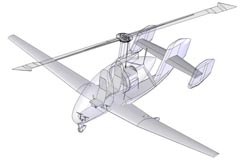 A Jetsons-like levitating autogyro will be a step closer to reality with the infusion of expertise from four technology companies. Carter Aviation Technologies is ready to commercialize its long-term research into slowed rotor/compound (SR/C) aircraft technology. To bring the technology to the market, the company is turning to Liberty Aerospace (maker of the Liberty XL two-place airplane), VX Aerospace, Dynamic Composites, and Eagle Aviation Technologies. Letters of interest have been exchanged between the potential partners and Carter.
A Jetsons-like levitating autogyro will be a step closer to reality with the infusion of expertise from four technology companies. Carter Aviation Technologies is ready to commercialize its long-term research into slowed rotor/compound (SR/C) aircraft technology. To bring the technology to the market, the company is turning to Liberty Aerospace (maker of the Liberty XL two-place airplane), VX Aerospace, Dynamic Composites, and Eagle Aviation Technologies. Letters of interest have been exchanged between the potential partners and Carter.
With assistance from the companies, Carter plans to bring a family of personal air vehicles (PAV) to market—a two-place autogyro, two-place compound gyroplane, four-place autogyro, and four-place compound gyroplane. A compound gyroplane is essentially an autogyro with wings.
Company president Jay Carter has been a long-time developer of advanced rotor systems that allow rotors to turn at a faster rate than traditional helicopter rotors. Carter claims his new prototype four-place autogyro has vertical takeoff and landing capabilities with cruise speeds as high as 140 mph and a range of 600 miles at 7,500 feet. A planned turbocharged variant is expected to cruise at 223 mph with a range of 768 miles at 12,500 feet.
A four-place normally aspirated autogyro version is on display at EAA AirVenture this week. That prototype is scheduled to fly before the end of the year, according to Carter. He expects the flight test program to last about four months; then another three months will be needed to make expected modifications. The compound variant should fly in the summer of 2010, requiring about five months of flight test.
Carter plans to offer a kit-built version of the aircraft first. Once approximately 300 of those are flying, he plans to start a certification process.
Meanwhile, the company is exploring unmanned variants of the technology for special mission purposes.
With the SR/C rotor system, the aircraft can take off vertically, but it can’t be spun or stalled, according to Carter—improving safety.



